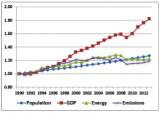Canada is one of the least densely populated countries on Earth, and yet 81% of the Canadian population live in urban centres. The country covers an area that is only slightly larger than China or the United States, but has a population of 36 million, ten times smaller than the population of the US and 40 times smaller than the population of China. With 90-95% of the population growth occurring in urban areas, an additional 13 million urban dwellers are projected by 2060. In Canada, urbanization took place simultaneously with the transition from an agriculturally based economy to an industrial economy fuelled by exponential growth in the production and consumption of fossil fuels and hydroelectricity.
Greenhouse gas emissions in Canada totaled 715 Mt CO2e in 2012, or 20.6 t CO2e per capita1, making it among the most greenhouse gas intensive economies in the world. The greenhouse intensity reflects both North American patterns of affluent, sprawling, automobile dependent, post-industrial urban communities, as well as the hinterland, energy-intensive, exported-oriented primary extraction and processing industries, including oil and gas. And yet, emissions per capita and emissions per dollar of GDP have been declining as the overall structure of the economy has continued to trend toward less energy intensive activities and the energy efficiency of buildings and vehicles has continued to improve.

